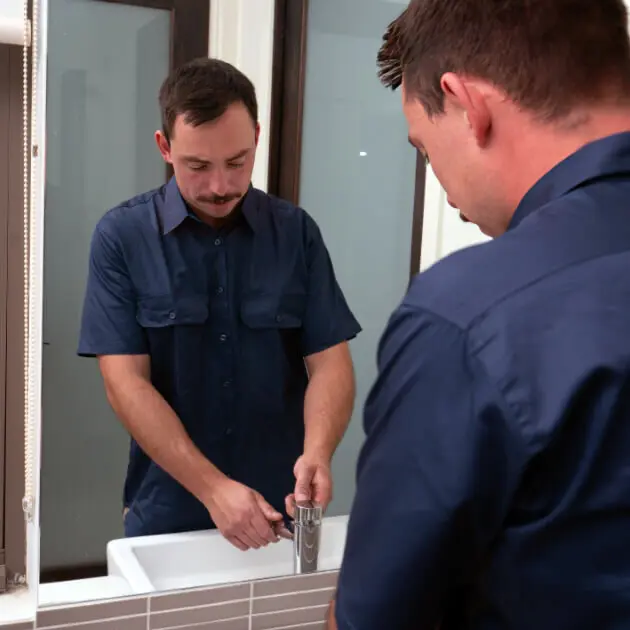Handy Bathroom Plumbing Guidelines for New Homeowners
Handy Bathroom Plumbing Guidelines for New Homeowners
Blog Article
The writer is making several great pointers related to 6 Essential Plumbing Checks for New Homeowners in general in this content just below.

For new house owners, understanding and preserving shower room pipes can conserve both time and money by protecting against costly issues down the line. Here are some essential shower room pipes suggestions to aid you keep whatever running efficiently.
Familiarize Yourself with the Key Shut-Off Valve
Knowing where the major water shut-off shutoff is located in your house is important. This permits you to promptly shut off the water system in case of significant leakages or during plumbing emergencies, stopping comprehensive water damages.
Consistently Inspect for Leakages
Small leakages can bring about large troubles. Regularly check under sinks, around toilets, and near pipes fixtures for any type of indications of leaks. Try to find dampness, tiny drips, or rust. Capturing and repairing leaks early can avoid much more serious damages and save water.
Don't Neglect Slow Drains Pipes
If your sink or tub is draining pipes slowly, it's often an indicator of a clog forming. Resolving this very early can avoid a complete blockage. Utilize a plunger or a plumbing's serpent to clean out particles. Prevent utilizing chemical drainpipe cleansers as they can harm your pipes with time.
Know What Not to Flush
Bathrooms are not waste disposal unit. Prevent flushing anything other than toilet tissue and human waste. Products like wipes, womanly hygiene items, and cotton swabs should be gotten rid of in the garbage to avoid blockages and sewer backups.
Mount Strainers in Drains
Location strainers in your sink and tub drains pipes to catch hair and other particles prior to they enter your plumbing system. Cleaning up the strainers routinely will help stop buildup and maintain water moving openly.
Maintain Your Hot Water Heater
Guarantee your water heater is readied to a suitable temperature level (generally around 120 degrees Fahrenheit) to avoid hot and minimize power use. Flush the storage tank every year to eliminate sediment buildup, which can reduce the performance and life-span of your heating system.
Upgrade Your Fixtures
If your home has older fixtures, consider updating to a lot more efficient models. Modern toilets, showerheads, and taps are made to utilize less water while giving great stress, which can considerably reduce your water expense and environmental footprint.
Be Cautious with Do It Yourself Plumbing Repair Works
While it's alluring to deal with all home repairs on your own, be cautious with pipes. Some problems may call for professional know-how, particularly if they entail main water lines or drain repair work. Employing a specialist can sometimes be much more economical than do it yourself, specifically if it protects against more damages.
Plan For Winter
Shield your pipelines from cold throughout cold weather by protecting pipes in unheated areas like cellars, attic rooms, and garages. During severe cool, allow cold water drip from taps served by subjected pipelines to aid prevent freezing.
Arrange Normal Upkeep
Think about organizing yearly evaluations with a qualified plumbing technician. They can identify concerns that you might miss, such as hidden leakages or wear and tear on pipelines and fixtures. Normal maintenance aids prolong the life of your pipes system and can stop emergencies.
Final thought
Understanding and preserving your home's bathroom plumbing can stop many common concerns. By following these essential pointers, you can ensure your washroom stays functional and reliable, saving you time and money in the long run.
Essential Plumbing Tips for Homeowners: Keep Your Pipes Flowing Smoothly
As a homeowner, understanding the basics of your plumbing system can save you time, money, and a lot of headaches. Plumbing issues can range from minor annoyances like dripping faucets to major problems like burst pipes that cause significant damage. This guide provides essential tips to help you maintain your plumbing system and tackle common issues.
Understanding Your Plumbing System
Supply System: Brings fresh water into your home from a municipal source or a well. Drain-Waste-Vent System: Removes wastewater and vents sewer gases outside. Fixtures and Appliances: Includes sinks, toilets, showers, dishwashers, and washing machines. Basic Maintenance Tips
Regular Inspections: Periodically check for leaks, corrosion, and other signs of wear and tear. Look under sinks, around toilets, and near water heaters. Know Your Main Shut-Off Valve: In case of a major leak, you’ll need to shut off the water quickly. Ensure everyone in your household knows where the main shut-off valve is located. Prevent Frozen Pipes: In cold climates, insulate exposed pipes and let faucets drip during extreme cold to prevent freezing. Use Strainers: Install strainers in sinks and tubs to catch hair, food particles, and other debris that can cause clogs. Common Plumbing Issues and Solutions
Clogged Drains:
Prevention: Avoid pouring grease down the drain and use drain screens to catch debris. DIY Fix: Use a plunger or a plumbing snake to clear minor clogs. For stubborn clogs, a mixture of baking soda and vinegar can sometimes help. Leaky Faucets:
Prevention: Replace washers and seals regularly. DIY Fix: Turn off the water supply, disassemble the faucet, and replace worn parts.

Go Deal Now Report this page